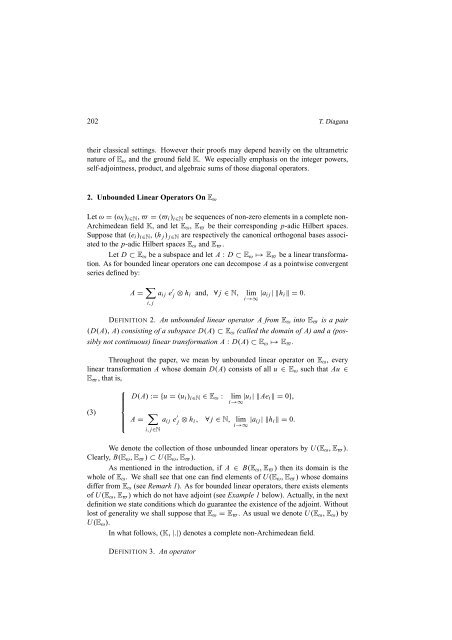T. Diagana INTEGER POWERS OF SOME UNBOUNDED LINEAR ...
T. Diagana INTEGER POWERS OF SOME UNBOUNDED LINEAR ...
T. Diagana INTEGER POWERS OF SOME UNBOUNDED LINEAR ...
Create successful ePaper yourself
Turn your PDF publications into a flip-book with our unique Google optimized e-Paper software.
202 T. <strong>Diagana</strong><br />
their classical settings. However their proofs may depend heavily on the ultrametric<br />
nature of E ω and the ground field K. We especially emphasis on the integer powers,<br />
self-adjointness, product, and algebraic sums of those diagonal operators.<br />
2. Unbounded Linear Operators On E ω<br />
Let ω = (ω i ) i∈N , ̟ = (̟i) i∈N be sequences of non-zero elements in a complete non-<br />
Archimedean field K, and let E ω , E̟ be their corresponding p-adic Hilbert spaces.<br />
Suppose that (e i ) i∈N , (h j ) j∈N are respectively the canonical orthogonal bases associated<br />
to the p-adic Hilbert spaces E ω and E̟ .<br />
Let D ⊂ E ω be a subspace and let A : D ⊂ E ω ↦→ E̟ be a linear transformation.<br />
As for bounded linear operators one can decompose A as a pointwise convergent<br />
series defined by:<br />
A = ∑ i, j<br />
a i j e ′ j ⊗ h i<br />
and, ∀ j ∈ N, lim<br />
i→∞ |a i j| ‖h i ‖ = 0.<br />
DEFINITION 2. An unbounded linear operator A from E ω into E̟ is a pair<br />
(D(A), A) consisting of a subspace D(A) ⊂ E ω (called the domain of A) and a (possibly<br />
not continuous) linear transformation A : D(A) ⊂ E ω ↦→ E̟ .<br />
Throughout the paper, we mean by unbounded linear operator on E ω , every<br />
linear transformation A whose domain D(A) consists of all u ∈ E ω such that Au ∈<br />
E̟ , that is,<br />
(3)<br />
⎧<br />
⎪⎨<br />
⎪⎩<br />
D(A) := {u = (u i ) i∈N ∈ E ω :<br />
A = ∑<br />
i, j∈N<br />
lim |u i| ‖Ae i ‖ = 0},<br />
i→∞<br />
a i j e ′ j ⊗ h i, ∀ j ∈ N, lim<br />
i→∞ |a i j| ‖h i ‖ = 0.<br />
We denote the collection of those unbounded linear operators by U(E ω , E̟).<br />
Clearly, B(E ω , E̟) ⊂ U(E ω , E̟).<br />
As mentioned in the introduction, if A ∈ B(E ω , E̟) then its domain is the<br />
whole of E ω . We shall see that one can find elements of U(E ω , E̟) whose domains<br />
differ from E ω (see Remark 1). As for bounded linear operators, there exists elements<br />
of U(E ω , E̟) which do not have adjoint (see Example 1 below). Actually, in the next<br />
definition we state conditions which do guarantee the existence of the adjoint. Without<br />
lost of generality we shall suppose that E ω = E̟ . As usual we denote U(E ω , E ω ) by<br />
U(E ω ).<br />
In what follows, (K,|.|) denotes a complete non-Archimedean field.<br />
DEFINITION 3. An operator














